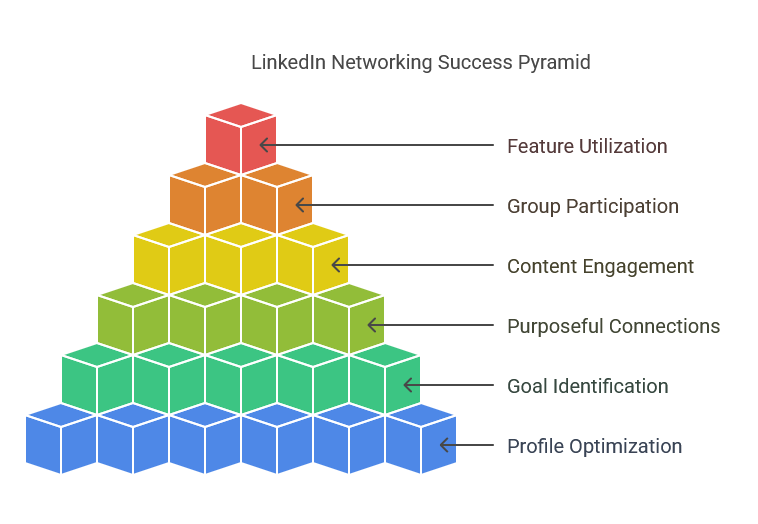strategic networking on linkedin
Networking is one of the cornerstones of professional growth, and LinkedIn is the ultimate platform for building meaningful connections. Whether you’re seeking career opportunities, partnerships, or industry insights, having a robust LinkedIn network can open doors. This blog will guide you through crafting a powerful networking strategy tailored to LinkedIn.
Why Networking on LinkedIn Matters
- Access to Opportunities: Recruiters and hiring managers often use LinkedIn to find candidates.
- Professional Growth: Gain insights and learn from industry leaders by staying connected with your network.
- Brand Visibility: A large, engaged network amplifies your content and personal brand.
- Collaboration and Support: Collaborate with peers, find mentors, or share expertise within your field.
Step-by-Step LinkedIn Networking Strategy
1. Optimize Your Profile for Networking
Before you start connecting, ensure your profile makes a strong impression:
- Profile Picture: Use a clear, professional photo.
- Headline: Highlight your current role or professional aspirations.
- About Section: Write a summary that showcases your skills, achievements, and goals.
- Experience and Skills: Keep your experience section detailed and relevant, and list key skills for endorsements.
2. Define Your Networking Goals
Be clear about why you’re building your LinkedIn network:
- Are you seeking job opportunities?
- Do you want to connect with industry peers?
- Are you looking for mentorship or business collaborations?
Defining your goals helps you identify the right people to connect with and ensures your efforts align with your objectives.
3. Identify and Connect with the Right People
- Colleagues and Classmates: Start with people you know from work, school, or professional events.
- Industry Leaders: Follow and connect with thought leaders and influencers in your field.
- Recruiters and Hiring Managers: If you’re job hunting, build relationships with professionals in recruitment.
- Alumni Networks: Use LinkedIn’s alumni tool to find connections from your school or university.
4. Personalize Connection Requests
Always include a message when sending connection requests:
- Mention how you know the person or why you’re interested in connecting.
- Keep your message short, respectful, and professional.
- Example: “Hi [Name], I admire your work in [industry] and would love to connect to learn more about your experiences.”
5. Engage with Your Network
Building a network isn’t just about adding connections; it’s about nurturing relationships:
- Comment on Posts: Add thoughtful insights to posts from your network.
- Share Valuable Content: Post articles, tips, or updates relevant to your field.
- Celebrate Achievements: Congratulate your connections on promotions, certifications, or milestones.
- Send Periodic Messages: Check in with your network to maintain relationships.
6. Leverage LinkedIn Groups
Joining groups related to your industry or interests is a great way to meet like-minded professionals:
- Participate in discussions and share your expertise.
- Network with group members by engaging with their posts or sending connection requests.
7. Attend LinkedIn Events
LinkedIn often features virtual events, webinars, and live streams:
- Use these opportunities to learn and connect with attendees.
- After the event, follow up with participants and speakers.
8. Utilize LinkedIn’s Tools
- Search Filters: Use advanced search filters to find professionals based on location, industry, or company.
- Open to Work Feature: If you’re job hunting, activate this feature to signal availability to recruiters.
- LinkedIn Sales Navigator: For those in sales or business development, this premium tool offers advanced networking capabilities.Strategic Networking on LinkedInStrategic Networking on LinkedIn

Mistakes to Avoid When Networking on LinkedIn
- Sending Generic Requests: Always personalize your connection requests.
- Overloading Your Network: Focus on quality over quantity when connecting with others.
- Ignoring Engagement: Failing to interact with your connections can make your network stagnant.
- Being Too Salesy: Avoid making your interactions solely about selling or promoting yourself.Strategic Networking on LinkedInStrategic Networking on LinkedIn
The Importance of Consistency
Building a strong network takes time and consistent effort. Dedicate time each week to:
- Sending connection requests.
- Engaging with your network’s posts.
- Sharing updates or valuable insights.Strategic Networking on LinkedIn
Over time, your efforts will lead to a well-rounded and engaged LinkedIn network.
Conclusion
Strategic networking on LinkedIn can propel your career and open doors to countless opportunities. By optimizing your profile, defining clear goals, and engaging meaningfully with your network, you can establish a strong professional presence. Start building your network today and watch your LinkedIn connections transform into valuable relationships and career advancements!

